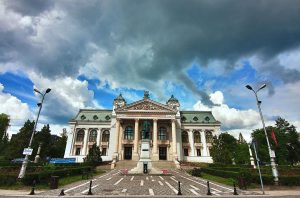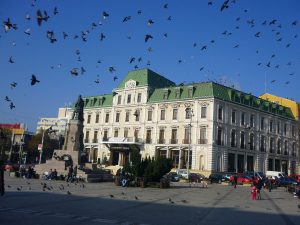Major events in the political and cultural history of Moldavia are connected with the name of the city of Iași. The great scholars of the 17th century, Grigore Ureche, Miron Costin and later Ion Neculce, wrote most of their works in the city or not far from it and the famous scholar Dimitrie Cantemir known throughout all Europe also linked his name to the capital of Moldavia.
 The first newspaper in Romanian language was published in 1829 in Iași and it is in Iași where, in 1867, appeared under literary society Junimea, the Convorbiri Literare review in which Ion Creangă’s Childhood Memories and the best poems by Mihai Eminescu were published.
The first newspaper in Romanian language was published in 1829 in Iași and it is in Iași where, in 1867, appeared under literary society Junimea, the Convorbiri Literare review in which Ion Creangă’s Childhood Memories and the best poems by Mihai Eminescu were published.
Many great personalities of Romanian culture are connected to Iași: the historian and politic men Mihail Kogălniceanu, the poets Vasile Alecsandri or George Topârceanu, the writers Mihail Sadoveanu, Alecu Russo, or Ionel Teodoreanu, the literary critic Titu Maiorescu, the historian A.D. Xenopol, the philosophers Vasile Conta or Petre Andrei, the geographer Emil Racoviță, the painter Octav Băncilă, or the scientist Stefan Procopiu.
Iași is home to many museums, memorial houses, art galleries.
First memorial museum from Romania opened in Iași in 1918, as the Ion Creangă Memorial House, and today the Iași Romanian Literature Museum owns 14 memorial houses. The Mihai Eminescu Museum, situated in Copou Park, is dedicated to the great poet’s life and creation; other museums are dedicated to: Dosoftei, Mihail Kogălniceanu, Vasile Pogor, Nicolae Gane, Petru Poni, Mihail Sadoveanu, George Topîrceanu, Otilia Cazimir, Cezar Petrescu.
 The Union Museum, includes original pieces and documents which belonged to prince Al. I. Cuza and his family.
The Union Museum, includes original pieces and documents which belonged to prince Al. I. Cuza and his family.
The Natural History Museum, founded on 4 February 1834, is the first museum of this kind in Romania with over 300,000 items, the most valuable being the collections of insects, mollusk, amphibians, reptiles, birds, plants and minerals.
Four other museums are located in the Palace of Culture: with its roots dating back to 1860, the Iași Art Museum is the oldest of its kind in Romania and, with more than 8,700 works (many of them belonging to the universal patrimony), has the largest art collection in the country; the Moldavia’s History Museum, offers more than 48,000 objects from various fields, archaeology, numismatics, decorative art, ancient books, documents; the Ethnographic Museum of Moldavia owns more than 13,000 objects depicting the Romanian advance through the ages; the Science and Technology Museum’s collection has more than 11,200 objects in five distinct sections and one memorial house.
